Japanese
English
- 有料閲覧
- Abstract 文献概要
- 1ページ目 Look Inside
- サイト内被引用 Cited by
はじめに
胃の良悪性境界病変の大部分を占めるものとして腺腫に類似した病変が存在することは古くから知られていたが,これらの病理学的なdisease entityを腺腫とするか,腸上皮化生の発生過程に生じた異分化(dysplasia)とみるかは,永い間,議論の分かれるところであった.しかし,1979年にWHOが,このような病変の大部分を腺腫の範疇として分類したことにより,本病変に対する共通の認識が得られるようになった.
筆者らは当院開設以来1986年までに,腺腫(腺腫内癌を含む)の手術例,および非手術例(生検診断による旧分類のGroupⅢ病変),生検上腺腫と誤診した癌腫などのうち,内視鏡写真良好例として399例460病変を得ている.本稿では,これらの臨床病理学的性状や内視鏡所見を比較検討することによって,腺腫のmalignant potentialを示し,得られた成績から本病変における高危険群の取り扱いなどについて述べてみたい.
Four hundred and sixty adenomas in 399 cases were identified and well documented photographically by histological examination of biopsy and/or resected specimen at National Cancer Center Hospital during the period between 1962 and 1986. The malignant potentials were examined endoscopically and clinicopathologically in these 460 lesions.
The results obtained were as follows:
1) Of the 460, 423 lesions were histologically diagnosed as Group Ⅲ (adenoma) by biopsy. Of the 423, 184 were resected following biopsy with the final histological diagnosis, adenoma in 154, focal carcinoma arising from adenoma in 9, and carcinoma in 21 lesions. The malignant potential in this group, therefore, corresponded to 16% (30/194). On the other hand, of the 460, 217 lesions were resected, and included 176 lesions of adenoma and 20 lesions of focal cancer. Hence, the malignant potential in gastric adenoma resected was estimated as 10% (20/196).
2) Endoscopic and clinicopathological characteristics of the adenomas with malignant lesions were summarized as follows; polypoid or gastritis-like type, larger than 2 cm in size, reddish surface endoscopically, mixed with depressed component within the lesion such as Ⅱa+Ⅱc or Ⅱc type early cancer macroscopically.
3) According to multivariate analysis by quantification theory No. 2 by Hayashi, partial coefficiency to malignancy that corresponds to weight of each finding concerning to the malignant potential of adenomatous lesions was highest in the color, followed by the size, the macroscopic type and the combination with depressed component. These items were useful in differentiating malignant from benign cases with statistical signif icance (p<0.01).
The results stated above suggest that gastric adenomas or Group Ⅲ lesions evidently have the malignant potential and that it is possible to pick up high risk patients for malignancy based on endoscopic findings. When a patient has a Group Ⅲ lesion, for example, showing a reddish, large, marked polypoid or gastritis-like appearance and/or depressed component, short term (within three or six months) follow up by endoscopy and biopsy should be in order.

Copyright © 1987, Igaku-Shoin Ltd. All rights reserved.


